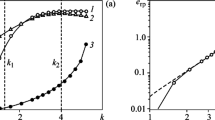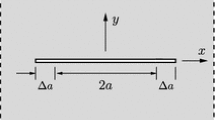Abstract
In this brief note, we provide the failure stress of a solid containing a penny-shaped crack by means of Finite Fracture Mechanics. The solution is analytical up to the numerical root of the equation providing the finite crack growth increment. Results are discussed and compared with the ones provided by Linear Elastic Fracture Mechanics, by Theory of Critical Distances and by Cohesive Crack Model (with a Dugdale-type cohesive law).









Similar content being viewed by others
References
Broberg KB (1999) Cracks and fracture. Academic Press, London
Camanho PP, Erçin GH, Catalanotti G, Mahdi S, Linde P (2012) A finite fracture mechanics model for the prediction of the open-hole strength of composite laminates. Compos Part A 43:1219–1225
Cornetti P, Pugno N, Carpinteri A, Taylor D (2006) Finite fracture mechanics: a coupled stress and energy failure criterion. Eng Fract Mech 73:2021–2033
Cornetti P, Sapora A, Carpinteri A (2014) Finite fracture mechanics versus cohesive crack modelling: an analytical comparison based on case studies. In: 16th European conference on composite materials, ECCM 2014
Cornetti P, Sapora A, Carpinteri A (2016) Short cracks and V-notches: finite fracture mechanics versus cohesive crack model. Eng Fract Mech 168:2–12
Cornetti P, Muñoz-Reja M, Sapora A, Carpinteri A (2019) Finite fracture mechanics and cohesive crack model: weight functions versus cohesive laws. Int J Solids Struct 156–157:126–136
Doitrand A, Leguillon D (2018) 3D application of the coupled criterion to crack initiation prediction in epoxy/aluminum specimens under four point bending. Int J Solids Struct 143:175–182
Dugdale DS (1960) Yielding of steel sheets containing slits. J Mech Phys Solids 8:100–108
Felger J, Rosendahl PL, Leguillon D, Becker W (2019) Predicting crack patterns at bi-material junctions: a coupled stress and energy approach. Int J Solids Struct 164:191–201
Gentieu T, Jumel J, Catapano A, Broughton J (2019) Size effect in particle debonding: Comparisons between finite fracture mechanics and cohesive zone model. J Compos Mater 14:1941–1954
Hashin Z (1996) Finite thermoelastic fracture criterion with application to laminate cracking analysis. J Mech Phys Solids 44:1129–1145
Kelly PA, Nowell D (2000) Three-dimensional cracks with Dugdale-type plastic zones. Int J Fract 106:291–309
Kfouri AP (1979) Continuous crack growth or quantized growth steps? Int J Fract 15:23–29
Leguillon D (2002) Strength or toughness? A criterion for crack onset at a notch. Eur J Mech A Solids 21:61–72
Leguillon D (2014) An attempt to extend the 2D coupled criterion for crack nucleation in brittle materials to the 3D case. Theor Appl Fract Mech 74:7–17
Mantič V (2009) Interface crack onset at a circular cylindrical inclusion under a remote transverse tension. Application of a coupled stress and energy criterion. Int J Solids Struct 46:1287–1304
Neimitz A, Aifantis EC (1987) On the length of crack jump during subcritical growth. Eng Fract Mech 26:505–518
Pugno NM, Ruoff RS (2004) Quantized fracture mechanics. Philos Mag 84:2829–2845
Sapora A, Cornetti P (2018) Crack onset and propagation stability from a circular hole under biaxial loading. Int J Fract 214:97–104
Sneddon IN (1946) The distribution of stress in the neighbourhood of a crack in an elastic solid. Proc R Soc (Lond) A187:229–260
Tada H, Paris P, Irwin G (2000) The stress analysis of cracks handbook. ASME Press, New York
Taylor D (2007) The theory of critical distances. Elsevier Science, Amsterdam
Weißgraeber P, Becker W (2013) Finite fracture mechanics model for mixed mode fracture in adhesive joints. Int J Solids Struct 50:2383–2394
Yosibash Z, Mittelman B (2016) A 3-D failure initiation criterion from a sharp V-notch edge in elastic brittle structures. Eur J Mech A Solids 60:70–94
Yosibash Z, Priel E, Leguillon D (2006) A failure criterion for brittle elastic materials under mixed-mode loading. Int J Fract 141:291–312
Author information
Authors and Affiliations
Corresponding author
Additional information
Publisher's Note
Springer Nature remains neutral with regard to jurisdictional claims in published maps and institutional affiliations.
Rights and permissions
About this article
Cite this article
Cornetti, P., Sapora, A. Penny-shaped cracks by Finite Fracture Mechanics. Int J Fract 219, 153–159 (2019). https://doi.org/10.1007/s10704-019-00383-9
Received:
Accepted:
Published:
Issue Date:
DOI: https://doi.org/10.1007/s10704-019-00383-9




